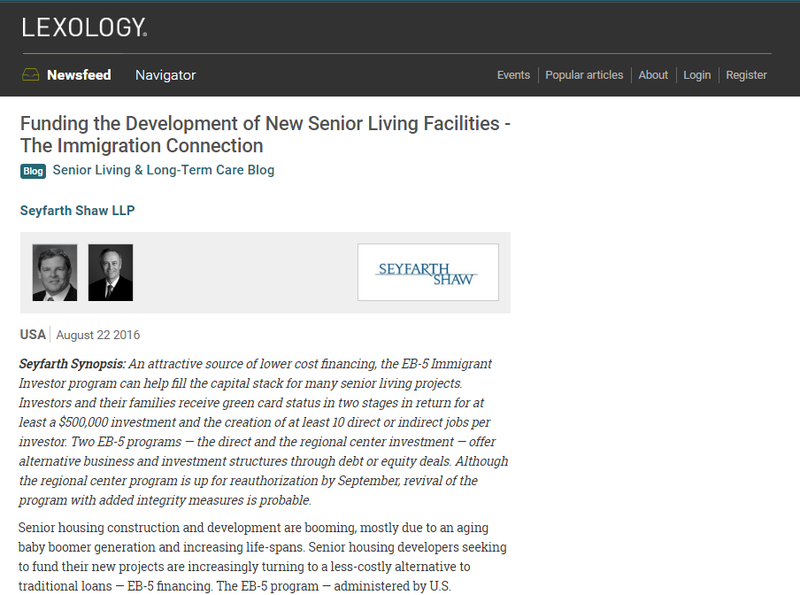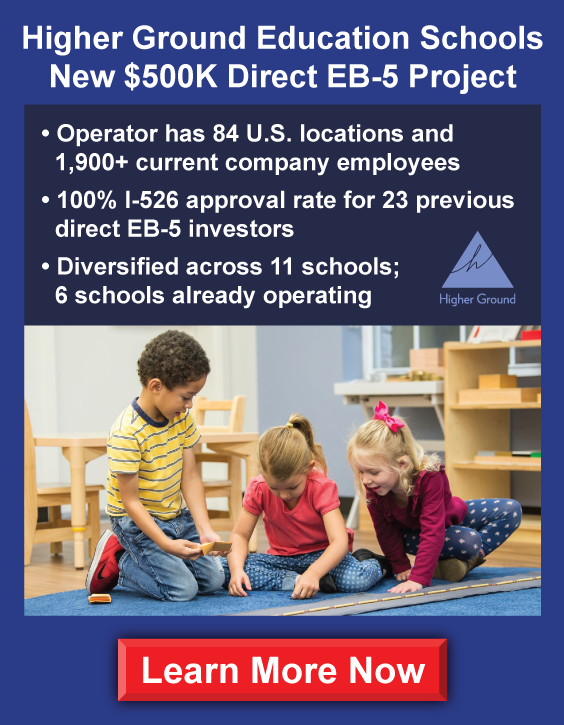Funding the Development of New Senior Living Facilities - The Immigration Connection
Senior housing construction and development are booming, mostly due to an aging baby boomer generation and increasing life-spans. Senior housing developers seeking to fund their new projects are increasingly turning to a less-costly alternative to traditional loans — EB-5 financing. The EB-5 program — administered by U.S. Citizenship and Immigration Services, a component of Department of Homeland Security, allows for the grant of green cards to foreign citizens who invest at least $500,000 in a qualifying project that is likely to create 10 or more jobs in the United States. Green cards are also issued to the investor’s spouse and unmarried children under age 21. Permanent residency is granted in two stages — a conditional residency period and, two years later, the grant of unconditional green card status as long as the investment has been sustained and treated as “at-risk,” and the required jobs have been created.
EB-5 capital can serve as part of the initial capital stack for a new venture (often as mezzanine financing) or be used to take out and repay higher-interest bridge or construction loans.
The Nuts and Bolts of the EB-5 Program:
There are two main methods of EB-5 investment – direct investing into the new commercial enterprise or investment through a regional center (i.e., an entity approved by the federal government to be involved in the EB-5 Program and the promotion of economic growth and job creation in a geographic area). Under the direct investment program, immigrant investors may only count direct jobs created for employees issued IRS Form W-2 by the “new commercial enterprise.” However, under the regional center investment model, investors are allowed to count direct, indirect and induced jobs. Although the regional center program is set to sunset on September 30, 2016, there is wide consensus that Congress will continue to extend the program because it provides jobs for U.S. workers and generates federal, state and local tax revenues. Also likely will be the inclusion in future EB-5 legislation of additional “integrity measures,” which would enhance investor protection and promote national security, while clarifying eligibility criteria. The direct EB-5 program, however, is not subject to reauthorization and thus will not sunset.
The EB-5 program requires that the immigrant investor invest at least $1,000,000 of capital in a new commercial enterprise that creates or, in some circumstances, saves no fewer than ten (10) jobs. However, there is a widely-used exception to the $1,000,000 investment requirement. If the immigrant investor invests capital in a new commercial enterprise that is principally doing business in, and creates jobs in, a “targeted employment area” (TEA), the investment amount is lowered to a minimum of $500,000 in capital. A qualifying TEA investment is one made in a specially defined “rural area” or an area that has experienced unemployment of at least 150 percent of the national average rate. Many TEAs involve the measurement of several census tracts (some with high and others with low unemployment) to achieve an average of 150 percent or greater. Most senior living facilities are constructed in a TEA for that very reason.
Direct, Indirect and Induced Jobs:
A direct job is an identifiable and actual position in the new EB-5 commercial enterprise for qualified U.S. employees. Each position must be full-time and provide at least 35 work hours each week to an employee at the business in which the investment was made. An alternative to a full-time position is a job-sharing option (which may not consist of multiple part-time positions). Senior living facilities are likely to create numerous direct jobs.
Indirect jobs are those created in businesses that are associated or affiliated with an EB-5 Regional Center. These jobs are still shown to have been created due to the capital invested by the immigrant investor. Indirect jobs are typically created within businesses that supply services or goods to the EB-5 project in question. Jobs associated with a construction project are a great example of indirect jobs. Actual construction jobs resulting from the project will only be counted as indirect jobs if the construction can be shown to require two years or more to be completed. Even for projects of shorter duration, however, the purchase of building and construction supplies, and other construction-related expenditures are treated as economic “inputs” leading to the calculation of indirectly created jobs.
Induced jobs are those that are created in the community in which the regional center is located. The increase in spending by workers involved in EB-5 projects in the community results in the creation of induced jobs (e.g., construction workers at the project site purchasing lunch at local eateries). Not only do projects create new jobs within the geographic scope of the project, but those new jobs create a “ripple effect” throughout the economy of the United States. For example, seniors who move into an assisted living facility pay monthly sums for lodging and care, which provide salaries for the facility’s workers and suppliers. These individuals use their compensation to purchase goods and services, which creates the ripple effect.
Developers generally rely on outside experts to assist in calculating indirect and induced jobs and to make sure that TEA classification is available. This work is done through detailed economic analysis, review of census tracts and unemployment data, and preparation of a business plan.
Cost of EB-5 Financing and Percentage of Capital Stack:
Compared to other sources of capital available to senior housing developers, the EB-5 Program provides a low-cost capital alternative for new projects when compared to traditional loans. EB-5 investors do not invest capital primarily for a return on their investment. The goal for such investors is permanent residence in the United States. As a result, immigrant investors are often willing to accept modest returns on their investment.
Generally, the EB-5 capital component represents less than 30% of the total project costs and it is often less than 15%. But even when the percentage of total cost of a project is small, all of the jobs created by the project are credited to the EB-5 investors (not just the pro-rata portion represented by the EB-5 capital). In other words, all of the jobs created by the project, including those resulting from other capital sources, are allocated to the EB-5 investors.
Senior living is a growth industry which shows no immediate signs of letting up. EB-5 continues to serve an important role in fueling the growth of development and related job creation for the industry. EB-5 compliance and satisfaction of the program’s eligibility criteria, however, are quite technical. Thus, representation by competent counsel and other professionals is essential.
http://www.lexology.com/library/detail.aspx?g=286b3ca3-fab5-4ee2-9cc1-f0ac971bde7e
Mentions
States
- California
Securities Disclaimer
This website is for informational purposes only and does not constitute an offer or solicitation to sell shares or securities. Any such offer or solicitation will be made only by means of an investment's confidential Offering Memorandum and in accordance with the terms of all applicable securities and other laws. This website does not constitute or form part of, and should not be construed as, any offer for sale or subscription of, or any invitation to offer to buy or subscribe for, any securities, nor should it or any part of it form the basis of, or be relied on in any connection with, any contract or commitment whatsoever. EB5Projects.com LLC and its affiliates expressly disclaim any and all responsibility for any direct or consequential loss or damage of any kind whatsoever arising directly or indirectly from: (i) reliance on any information contained in the website, (ii) any error, omission or inaccuracy in any such information or (iii) any action resulting therefrom.




